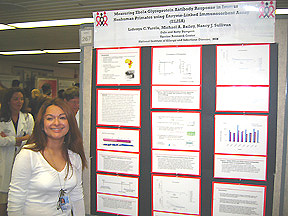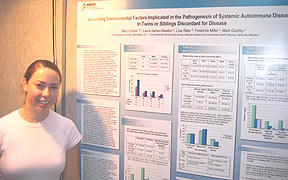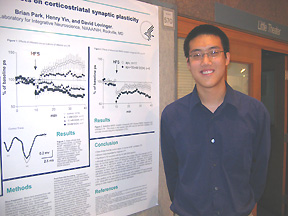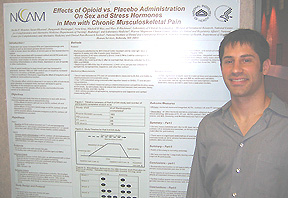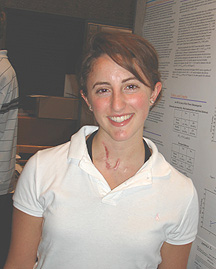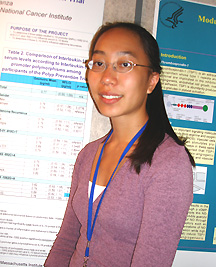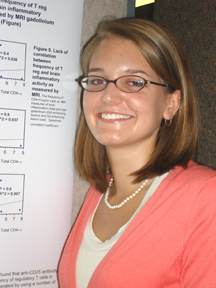SUMMER POSTER DAY: SO MANY QUESTIONS EN ROUTE TO ANSWERS
by Dustin Hays
and Fran Pollner
A record 670 students in NIH summer research programs presented 651 posters on Poster Day August 3. Here are write-ups of 11—all of which are works in progress. They ask these questions:
![]() Will a mulitivalent Ebola virus vaccine achieve protective immunity against
both the Sudan and the Zaire virus strains?
Will a mulitivalent Ebola virus vaccine achieve protective immunity against
both the Sudan and the Zaire virus strains?
![]() What are the pathways by which alcohol affects long-term potentiation
and related memory and learning?
What are the pathways by which alcohol affects long-term potentiation
and related memory and learning?
![]() Will opioid medication to alleviate osteoarthritis-induced musculoskeletal
pain adversely affect sex and stress hormone levels in men?
Will opioid medication to alleviate osteoarthritis-induced musculoskeletal
pain adversely affect sex and stress hormone levels in men?
![]() What environmental factors play a role in the development of autoimmune
diseases in discordant twins or siblings?
What environmental factors play a role in the development of autoimmune
diseases in discordant twins or siblings?
![]() Do complications during pregnancy increase the risk of schizophrenia in
the offspring?
Do complications during pregnancy increase the risk of schizophrenia in
the offspring?
![]() Can dental-pulp stem cells serve as a source of differentiated neuronal
cells?
Can dental-pulp stem cells serve as a source of differentiated neuronal
cells?
![]() Can patients with multiple sclerosis benefit from an agent approved for
use in preventing transplant rejection and treating uveitis?
Can patients with multiple sclerosis benefit from an agent approved for
use in preventing transplant rejection and treating uveitis?
![]() Do the same criteria for metabolic syndrome hold for both African-American
and Caucasian adolescents?
Do the same criteria for metabolic syndrome hold for both African-American
and Caucasian adolescents?
![]() What is the relationship of chronic stress to telomerase activity?
What is the relationship of chronic stress to telomerase activity?
![]() Do certain cytokine promoter polymorphisms predict risk for polyp relapse
and colon cancer?
Do certain cytokine promoter polymorphisms predict risk for polyp relapse
and colon cancer?
![]() What demographic factors contribute most to self-reported health status?
What demographic factors contribute most to self-reported health status?
EBOLA VACCINE PACKING A ONE-TWO PUNCH Lidenys Varela, Johns Hopkins University, Baltimore, Md. "Measuring Ebola Glycoprotein Antibody Response in Immunized Nonhuman Primates Using Enzyme-Linked Immunosorbent Assay (ELISA)" Co-authors: Michael Bailey and preceptor Nancy Sullivan, Biodefense Research Section, NIAID-VRC Mortality after Ebola virus outbreaks are as high as 90 percent. Two Ebola virus subtypes, the Zaire strain (Z) and the Sudan strain (S), account for 99 percent of all human Ebola-related deaths. There is currently no licensed vaccine for Ebola, but an effort is underway at NIH to develop a multivalent vaccine that protects against both virus strains. Lidenys Varela, who is starting her sophomore year at Hopkins, tested the immunogenicity of a combination genetic Z/S Ebola vaccine in cynomolgus macaques. Essentially two vaccines delivered simultaneously, each consisted of an adenoviral vector encoding slightly different Ebola virus surface glycoproteins—GP(Z) and GP(S). In a previous study, the GP(Z) vaccine generated a robust immune response, as measured by antibody production, and protected macaques against challenge with live Zaire virus. Three weeks after immunization with the combination vaccine, sera from eight macaques were assayed via enzyme-linked immunosor-bent assay (ELISA) to determine specific GP(Z) and GP(S) antibody responses. In all cases, Zaire strain–specific antibody production was similar to that in the previous study in which all macaques survived subsequent challenge with live Zaire virus. In all but one subject, GP(S) generated antigen-specific antibody titers that rivaled those for GP(Z), suggesting that multiple antigens can be included in the vaccine and simultaneously elicit robust immune responses. Why one macaque did not demonstrate a GP(S) response is not known, Varela said, but she noted that the ELISA data indicate that all the other macaques developed protective immunity against the Sudan as well as the Zaire strain.
AUTOIMMUNE DISEASE AND THE ENVIRONMENT OF DISCORDANT SIBS Mary Conlon, Georgetown University, Washington, D.C. "Assessing Environmental Factors Implicated in the Pathogenesis of Systemic Autoimmune Diseases in Twins or Siblings Discordant for Disease" Co-authors: Laura James-Newton, Lisa Rider, and preceptors Mark Gourley and Frederick Miller, Office of Clinical Research, Environmental Autoimmunity Group, NIEHS Little is known about the causes of autoimmune disorders, but as Mary Conlon pointed out in her poster presentation, a less than 50 percent autoimmune disease concordance in monozygotic twins presents "strong evidence for an environmental influence." Conlon, who is entering her senior year at Georgetown, examined data gathered through the NIEHS Twin-Sibs study, conducted at the NIH Clinical Center, to identify environmental risk factors associated with four specific autoimmune disorders—rheumatoid arthritis, scleroderma, systemic lupus erythematosus, and myositis. Patients with one of these four conditions and an unaffected twin or same-sex sibling separated in age by no more than 47 months made up the study group; healthy volunteers who did not have an affected sibling made up the control group. Subjects underwent a physical examination and completed an extensive questionnaire about their health history and exposure to suspected environmental risk factors. Conlon analyzed data related to vaccination history, past infections, ultraviolet light sensitivity, and past surgical procedures. Initial results of this ongoing study (more families are being recruited) show a significant association between prior Herpes zoster infection and the subsequent development of autoimmune disease. Other environmental exposures continue to be evaluated as possible risk factors.
ALCOHOL AND NEURONAL SYNAPSES Brian S. Park, University of Maryland, College Park "Ethanol Effects on Corticostriatal Synaptic Plasticity" Co-authors: David Lovinger and preceptor Henry Yin, Laboratory for Integrative Neuroscience, NIAAA Generally defined as the long-lasting strengthening of a neuronal synapse, long-term potentiation (LTP) in the central nervous system is believed to play an important role in learning and memory. Brian Park, a college sophomore, examined ethanol’s (EtOH) effects on LTP using an in vitro rat model consisting of a fresh coronal brain slice comprising the dorsomedial striatum–a region known to contribute to memory. Brain slices were bathed in an artificial cerebral spinal fluid to which ethanol was added to concentrations 2 mM, 10 mM, and 50 mM. Using this model, Park took field potential readings to measure LTP. The readings were made by stimulating the striatum via small electric pulses emitted through a tiny electrode inserted into the brain slice. Transmissions were then received through a second recording electrode inserted nearby—along a neuronal pathway leading through the striatum. Once a baseline measurement was established, a series of high-frequency stimulations (HFS) was delivered to the striatum, and then recording was resumed using the baseline stimulation parameters. The administration of HFS was used to induce LTP through the activation of calcium-dependent second-messenger systems in the postsynaptic cell. Normally, the signal received becomes greater, indicating that LTP has occurred and that synapses along the stimulated neuronal pathway have become stronger. Compared with controls, LTP of ethanol-exposed samples decreased in a dose-dependent manner and were significantly lower at the 50-mM EtOH concentration. Park also took LTP field potential readings of samples exposed to the NMDA receptor antagonist APV because ethanol is known to inhibit NMDA receptors, a type of glutamate receptor believed to induce LTP through signal transduction. LTP was significantly reduced in the presence of APV, but was reduced even further in the presence of APV plus 50 mM EtOH. This phenomenon, Park said, suggests that LTP may involve multiple pathways.
OPIOID PAIN RELIEF AND SEX AND STRESS HORMONES Justin Meunier, Louisiana State University School of Medicine, New Orleans "Effects of Opioid versus Placebo Administration on Sex and Stress Hormones in Men with Chronic Musculoskeletal Pain" Co-authors: Suzan Khoromi, Ranganath Muniyappa, Nora Gray, Mitchell Max, and preceptor Marc Blackman, Laboratory of Clinical Investigation, NCCAM Chronic musculoskeletal pain in the general population is underreported and undertreated. Opioid medications can help manage pain but may also affect sex and stress hormones in men—an associated drop in testosterone levels has been documented among male chronic heroin users, for instance. The clinical consequences of a decrease in testosterone, such as that naturally associated with aging or that induced by chronic opioid use, include loss of skeletal muscle mass and bone mass and an increased risk of heart disease. The sex hormones under investigation in the current study are leutinizing hormone (LH) and testosterone, and the stress hormones are adrenocorticotropic hormone (ACTH) and cortisol. Justin Meunier, now a second-year medical student, presented data from an ongoing two-part investigation of the effects of low-dose opioid administration on sex and stress hormones in men with chronic musculoskeletal pain due to osteoarthritis (OA). Part 1 of the study asked the question: "Does chronic pain alone have effects on male sex and stress hormones?"—an important question, Meunier observed, because it has been demonstrated that acute pain causes increased catecholaminergic axis activity and decreased gonadal steroid function. Based on findings in the 16 men with chronic OA pain and 12 healthy volunteers involved in the study, however, the answer, Meunier reported, is "No." The study was designed with stringent recruitment criteria, excluding individuals with confounding illnesses that might have affected findings, such as endocrine dysfunction, inflammatory arthritis, too high or too low body mass index, and depression. Men with a history of prior opioid use were also excluded. Thus, neuroendocrine function appears not to be significantly altered in healthy men with chronic musculoskeletal pain, suggesting that prior reports to the contrary resulted from the confounding effects of coexistent illness or medication use. Part 2 of the study, expected to be completed by the spring of 2007, asks the question: "Does low-dose administration of opioid medication or placebo have effects on male sex and stress hormones?" There are three study cohorts: an experimental treatment group given increasing doses of a brand of prescription, time-released morphine sulfate, an opioid; a placebo group; and a standardized treatment (nonopioid analgesic) group, which serves as a control for the placebo group so that placebo effects on the hormones in question may also be studied. The study involves two visits to the NIH Clinical Center for overnight blood sampling–one at the outset and one after the drug-escalation period. Blood is collected every 20 minutes for a 12-hour period and then analyzed for levels of ACTH, cortisol, LH, and testosterone. Also during both visits a 24-hour urine sample is collected to measure epinephrine, norepinephrine, dopamine, and cortisol.
EXTRACT OF WISDOM TEETH: A SOURCE OF STEM CELLS? Maiko Sakai, Harvard School of Dental Medicine, Boston "Investigation of Neuronal Differentiation Potential of Dental Pulp Stem Cells" Co-authors: Junji Mineshiba and preceptor Pamela Robey, Craniofacial and Skeletal Diseases Branch, NIDCR "There’s a lot being done to determine the potential of bone-marrow stem cells as a source of neural cells, but no one knows the potential of dental-pulp stem cells. This has been a really exciting project," said Maiko Sakai, describing her quest to establish neuronal cell differentiation in mouse and rat brain slices from stem cells originating in human dental pulp. The suggestion that dental pulp stem cells could be a source of neural cells emerged in a previous study demonstrating expression of neural markers in cell culture; the challenge now is to achieve similar results in organ culture and in vivo, Sakai said. During the course of her summer project, Sakai obtained pulp cells from adult third molars that had been extracted in the context of needed dental care; identified the mesenchymal stem cell marker CD146 by immunocytochemistry; carried out magnetic- and fluorescent-activated cell-sorting techniques, and fluorescently labeled the cells for tracing their activity in rat and mouse brain tissue. But she was doubtful that she would still be at NIH to observe firsthand the outcome of her work here. Her first attempt at preparing the tissue samples for her experiment fell short of perfect and, consequently, "my initial results are not that reliable," she said. Her technique improved the second time around—she collected more slices and from more propitious brain areas in the hippocampus that are known to house neural cells—but, she noted, there would probably be more time required for the differentiation process than she would have before returning to Boston for her second year at the Harvard School of Dental Medicine. The results of her first round of experiments suggest that dental-pulp cells survive in brain tissue, with some developing axon-like structures. Thus far, Sakai said, dental-pulp stem cells seem to have the potential for differentiating into neurons, "but we still don’t know."
OBSTETRIC FACTORS IN THE BIRTH OF SCHIZOPHRENIA Allie Gold, Maret School, Washington, D.C. "Obstetric Complications as a Risk Factor for Schizophrenia: Data from the Sibling Data Base Co-authors: Daniel Weinberger and preceptor Stefano Marenco, Clinical Brain Disorders Branch, NIMH "No one really knows that much about the causes of schizophrenia, and the results so far from our study are "iffy," Allie Gold observed, but the study is providing a foundation for the development of a new, more detailed questionnaire to probe the potential relationship of specific obstetric complications (OCs) and the development of schizophrenia in the affected offspring. The study compared information gathered from the NIMH Sibling Study with reports in the literature linking various OCs to later schizophrenia. These previous reports are not entirely consistent with one another regarding specific OC occurrence, severity, or patterns, and the current exploration yielded findings consistent with some reported associations and not others. Forceps delivery, Rh incompatibility, and the use of drugs—legal or illegal—during pregnancy emerged as significant factors in the later development of schizophrenia in offspring—the first two consistent with some previously reported findings and the third heretofore absent from discussion in the literature. Overall, however, the number and severity of OCs reflecting prematurity, fetal malnutrition, and fetal distress—including preeclampsia, a strongly associated finding in some previous studies—were similar in patients and control subjects in the current study. The influence of OCs on intelligence, as measured by the Wide Range Achievement Test (WRAT), was also examined. Patients had significantly lower WRAT scores than healthy volunteers, and patients with an OC history had lower WRAT scores than patients without an OC history. But there were also some unexpected WRAT findings, such as higher scores among healthy volunteers with an OC history and higher scores among both patients and healthy volunteers with a history of Rh incompatibility. The NIMH team gathered its information from responses to a questionnaire given to the mothers of 373 patients with schizophrenia and 380 control subjects whose offspring did not have schizophrenia. The response rate in the former group was 50 percent and that in the latter, 70 percent. This disparity in response rate was considered a potential source of bias, as was the mothers’ perhaps faulty memory regarding long-past obstetric events, Gold noted. The new questionnaire should help clarify some of these issues, she said. Gold’s NIH summer experience came between her junior and senior years in high school and a year after an accident in which she sustained a severe brain injury. She attributes her survival and complete recovery to an "incredible shock-trauma team and medical staff." Her intention, she said, is to become a doctor, "like everyone in my family," and focus on the brain and cognition.
TELOMERASE ACTIVITY, IMMUNE RESPONSE, AND CHRONIC STRESS Yixiao Zou, Georgia Institute of Technology, Atlanta "Telomere Length and Telomerase Activation in Peripheral Blood Lymphocytes of Chronically Stressed Individuals" Co-authors: preceptors Nan-ping Weng and Amanda Damjanovic, Laboratory of Immunology, NIA Recognizing the critical role of telomeres in the aging process and immune response, and prompted by the observation that chronically stressed individuals tend to have weakened immune responses, Yixiao Zou and his mentors investigated the effect of chronic stress—in the form of long-term caregiving to Alzheimer’s disease patients—on telomere length and telomerase activity in such primary caregivers. Data from 29 healthy caregivers (mostly spouses) 57 to 75 years old and their age- and sex-matched control subjects have been analyzed so far. "Telomere length, activation-induced T cell telomerase activity, as well as T cell proliferation rate, were comparable between two groups," Yixiao Zou acknowledged, "but further analysis is needed to characterize the duration and intensity of stress experienced by the caregivers." The one significant difference that emerged between the cohorts was a decreased percentage of natural killer cells in the caregivers, "which concurs with the weaker immune system hypothesis," Zou observed. The study cohorts were recruited by investigators at Ohio State University in Columbus, who collected and sent samples of peripheral blood mononuclear cells to the NIH researchers. The NIA researchers anticipate continuing this work—increasing the number of subjects and conducting a longitudinal study to determine the rate of telomere shortening and loss of telomerase activity, Zou said. A biomedical engineering student at Georgia Tech, Zou characterized the summer program as a "great hands-on experience" that will serve him well in his chosen field.
POLYMORPHISMS AND POLYPS RECURRENCE Grace Lee, Richard Montgomery High School, Rockville, Maryland "Interleukin-10 Promoter Gene Polymorphisms and Their Influence on Interleukin-10 Protein Levels among Participants in the Polyp Prevention Trial" Co-authors: Leah Sansbury and preceptor Elaine Lanza, Laboratory of Cancer Prevention, NCI-CCR In the summer after her graduation from Richard Montgomery High School in Rockville, Md., and preceding her freshman year at the Massachusetts Institute of Technology in Cambridge, Grace Lee explored the relationship of interleukin-10 (IL-10, an anti-inflammatory cytokine) promoter polymorphisms, IL-10 serum levels, and the risk of recurrence of adenomatous polyps in the colon—a precursor to colorectal cancer. She and her co-workers analyzed data collected from 558 people enrolled in the Polyp Prevention Trial. They focused on three polymorphisms of interest, with special attention to the G/G genotype of the -1082 polymorphism, an allele variously reported to be associated with increased and decreased levels of IL-10 in other studies, Lee said. In the current study, the other two polymorphisms (-819 and -592) had no apparent influence on IL-10 serum levels, but serum levels were significantly lower in individuals with the -1082 G/G genotype (P = 0.01). However, neither that genotype nor the lower serum levels of this anti-inflammatory cytokine appeared to correlate with an increased risk of adenoma recurrence over the four years covered by the data, a finding at theoretical odds with a previously reported association of the genotype with increased cancer risk. During the period covered by the study, 212 individuals experienced adenoma recurrence and 346 did not. The study cohort had a personal history of adenoma but not of colorectal cancer, their average age was 62, and the majority was white and male. More sophisticated statistical models that would adjust for individual and adenoma characteristics are on the team’s agenda, Lee said, as are studies on the influence of serum levels of other inflammation-related cytokines on adenoma recurrence. Her own plans, Lee added, include becoming a premed and majoring in biology.
EXPLORING DACLUZIMAB IN MS TREATMENT Caitlin Griffith, Grove City College, Grove City, Pennsylvania "Effect of Anti-CD25 Monoclonal Antibody Therapy on Regulatory T Cells in Patients with Multiple Sclerosis" Co-authors: preceptor Unsong Oh, Gregg Blevins, Nancy Richert, Henry McFarland, and preceptor Steve Jacobson, Neural Immunology Branch, NINDS Ongoing studies of anti-CD25 monoclonal antibody (dacluzimab)—an agent developed at NIH and already FDA-approved to treat uveitis and to prevent post-transplantation organ rejection—point to its potential therapeutic usefulness in ameliorating autoimmune disorders such as multiple sclerosis (MS). The current study sought to measure the ability of dacluzimab to block activation of regulatory T cells (T reg)—and also of activated effector CD4+ T cells—in patients with relapsing-remitting MS. A group of 10 patients with MS received dacluzimab infusions monthly for one year. Peripheral blood analysis showed a significant decline in T reg, as reflected in levels of T reg–specific markers such as Foxp3, and a somewhat smaller decline in effector T cells as well. Brain inflammatory activity, however, as revealed by MRI, did not correlate with T reg decline. Caitlin Griffith, a biochemistry major beginning her second college year, called the lack of correlation a "phenomenon." She noted that the MRI picture also "does not reflect the clinical findings" that have been reported to accompany dacluzimab administration. Continuing dacluzimab studies, she said, will include functional assays.
SELF-REPORTED HEALTH: THE INFLUENCE OF DEMOGRAPHICS Denisha Little, Winston-Salem State University, N.C., "The Link Between Self-reported Health and Demographics in the HANDLS Study" Co-authors: Michele Evans, Melissa Kitner-Triolo, and preceptor Alan Zonderman, Research Resources Branch, Clinical Research Branch, and Laboratory of Personality and Cognition, NIA If you know someone’s age, race, socioeconomic status, and perceived degree of friendliness in the neighborhood, you’ll have a pretty good idea of how that person views his or her health. Analysis of responses to an in-home questionnaire taken by 657 Baltimore residents enrolled in the HANDLS study (Healthy Aging in Neighborhoods of Diversity across the Life Span) supported most of the hypotheses informing the design of the questionnaire. As anticipated, older respondents, African-Americans, and people of lower socioeconomic status (SES) reported being in poorer health than participants who were younger, white, and of higher SES. Only one of several neighborhood characteristics expected to influence self-rated health status was borne out—agreeing that people not getting along well with one another was linked to poorer self-rated health. Contrary to expectations, women were no more likely than men to rate themselves healthy. Interestingly, low SES (below 125 percent of the poverty level) erased the differences in self-reported health status between whites and African-Americans. Although higher-SES whites reported better health than higher-SES African-Americans, lower-SES whites were as likely to report poorer health status as lower-SES African- Americans. For Denisha Little, a gerontology major–biology minor at Winston-Salem State University, establishing reliable predictors of self-reported health status is just the beginning of her explorations in the field. She will be returning to NIH next spring to spend her last semester continuing this research. On her research agenda are adding certain items to the questionnaire, correlating self-reported with actual health status of the participants, targeting particular areas in Baltimore to discern changes from one block to another, and parsing out "cultural" factors—such as diet, exercise, fear of the medical establishment—in self-reported and actual health status.
METABOLIC SYNDROME: THE INFLUENCE OF AGE AND RACE Benjamin Easter, Princeton University, Princeton, N.J. "Metabolic Syndrome and Insulin Sensitivity in African-American and Caucasian Children and Adolescents" Co-authors: Jennifer Gustafson, Margaret Rutledge, Joan Han, Sheila Brady, and preceptor Jack Yanovski, Unit on Growth and Obesity, Developmental Endocrinology Branch, NICHD The objective of the current study—involving 104 African-American and 161 Caucasian children ages 6 through 13—was to explore the relationship between metabolic syndrome and insulin sensitivity in the pediatric population and to examine the prevalence by race of the various components of metabolic syndrome. "The particular criteria used to diagnose metabolic syndrome in the pediatric population are debated, and its prognosis is unclear," Benjamin Easter said. "We are trying to untangle all the components and see how race figures into establishing criteria for metabolic syndrome." The study, he added, is part of two larger long-term studies on growth and obesity. Easter, now a senior at Princeton who will be applying to medical school, noted that his being an economics major had given him an edge in using a novel statistical model called "ordered probit analysis" to determine the effect of insulin sensitivity on the likelihood of an individual’s meeting from zero to five of the criteria for metabolic syndrome. The five components were age- and sex-specific cutoffs for waist circumference, blood pressure, HDL cholesterol, fasting glucose, and triglyceride level, with three or more of these deemed to constitute metabolic syndrome. The prevalence of metabolic syndrome did not differ by race, but the prevalence of triglyceride levels high enough to meet metabolic syndrome criteria was significantly lower in African-Americans, supporting findings in previous studies and suggesting that race-specific criteria might be appropriate, Easter said. Other race-specific differences fell short of statistical significance. Insulin sensitivity was ascertained both by the elaborate hyperglycemic clamp procedure and by fasting insulin and glucose levels (the QUICKI index). The two correlated well with one another, supporting the use of the more easily tolerated QUICKI method in clinical situations involving children, Easter noted. When controlling for age, race, sex, and body- mass index, insulin sensitivity as measured by the QUICKI index, but not hyperglycemic clamp, was significantly associated with meeting more criteria for metabolic syndrome. Of particular interest was the finding that three factors—body-mass index, waist circumference, and HDL cholesterol—were predictive of insulin sensitivity, but metabolic syndrome itself was not predictive when its individual components were included in the analysis. "It may be that the diagnosis of metabolic syndrome isn’t all that useful in children. Maybe just those three factors tell us what we need to know," Easter said.
|
